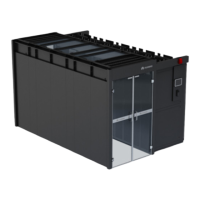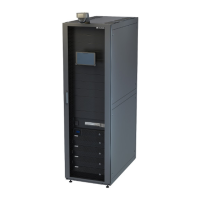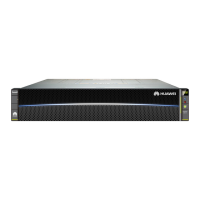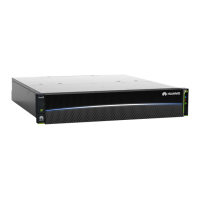● Do not store combustible materials in the battery room. Keep such materials
at least 3 m away from the battery room.
● A battery room deployed outdoors should be at least 3.0 m away from the
following places: restricted areas, combustible warehouses, dangerous goods,
high-stacking warehouses, power infrastructure, public roads, and buildings.
● The battery room should be isolated from the adjacent area by
re
compartmentation. Holes should be sealed by restop material. The re
resistance and thermal insulation capabilities should be the same as that of
the partition wall.
● The battery room should be equipped with re extinguishers lled with
halogenatedane,
heptauoropropane, peruorohexanone, carbon dioxide, or
dry powder. Each re protection unit should be equipped with at least two re
extinguishers, which should be checked and replaced periodically.
● The battery room should be equipped with cabinet-level or room-level CO
sensors, smoke sensors, and temperature sensors. It is recommended that H
2
sensors and open
ame sensors be deployed. At least two sensors of each
type should be deployed, and the automatic
re alarm system should be
enabled.
● The battery room should be equipped with independent air conditioners and
ventilation ducts, which must be isolated form those for other equipment
areas or
oce areas. If ventilation ducts are shared, re dampers must be
installed for the battery room. The ventilation and exhaust system must
interact with the
re alarm system and be able to handle ammable gases
with a concentration lower than 25% lower ammability limit (LFL).
● The battery room should be equipped with a halogenatedane or
peruorohexanone gas re extinguishing system, which should interwork with
the
re alarm system. After the extinguishing agent is released, the battery
room should meet the requirement on ame extinguishing concentration
within 10 min.
● The battery room should be equipped with re extinguishing facilities such as
a dry-type water spray or water mist pipe network to cope with the risk of
reignition or
re spreading after the battery re is extinguished.
● The battery room should be equipped with pressure relief explosion-proof
devices or pressure relief channels (such as glass windows and magnetic lock
doors) with equivalent areas. According to the NFPA 68 or GB 50016
standard, if side pressure relief is adopted, a protective fence or wall should
be installed outside the pressure relief channels, and the fence or wall should
be at least 12 m away from the pressure relief wall.
● The
re alarm system should interact with the ventilation and exhaust system
and automatic re extinguishing system, able to trigger the energy storage
system to disconnect the charging and discharging circuits.
● Fire alarms in the battery room should be automatically reported to the re
supervision center. If the battery room is unattended, an automatic re alarm
system must be deployed to report re alarm signals to the remote
management center.
Recycling
● Dispose of waste batteries in accordance with local laws and regulations. Do
not dispose of batteries as household waste. Improper disposal of batteries
may result in environmental pollution or an explosion.
FusionModule2000-S Smart Modular Data Center
User Manual 1 Safety Information
Issue 07 (2022-09-30) Copyright © Huawei Technologies Co., Ltd. 23

